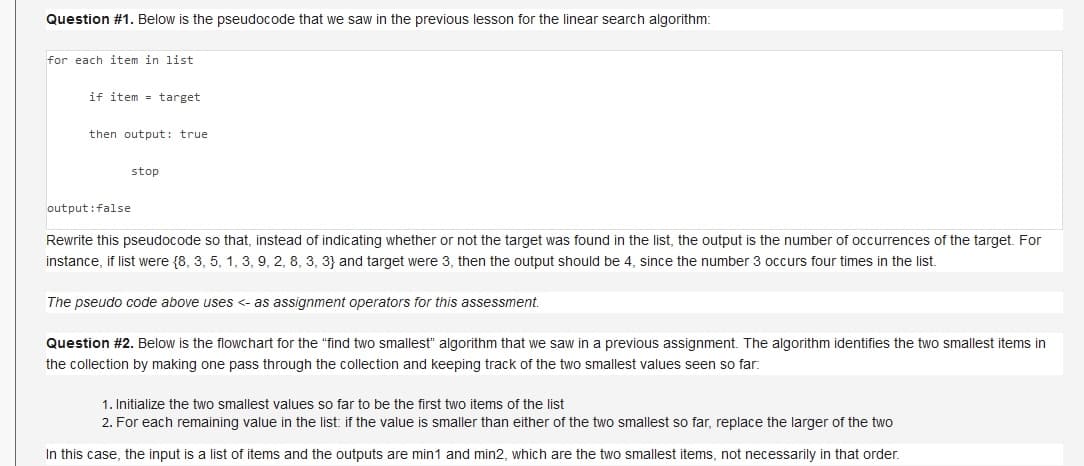Question #1. Below is the pseudocode that we saw in the previous lesson for the linear search algorithm: for each item in list if item = target then output: true stop output:false Rewrite this pseudocode so that, instead of indicating whether or not the target was found in the list, the output is the number of occurrences of the target. For instance, if list were {8, 3, 5, 1, 3, 9, 2, 8, 3, 3} and target were 3, then the output should be 4, since the number 3 occurs four times in the list. The pseudo code above uses <- as assignment operators for this assessment. Question #2. Below is the flowchart for the "find two smallest" algorithm that we saw in a previous assignment. The algorithm identifies the two smallest items in the collection by making one pass through the collection and keeping track of the two smallest values seen so far: 1. Initialize the two smallest values so far to be the first two items of the list 2. For each remaining value in the list: if the value is smaller than either of the two smallest so far, replace the larger of the two In this case, the input is a list of items and the outputs are min1 and min2, which are the two smallest items, not necessarily in that order.
Question #1. Below is the pseudocode that we saw in the previous lesson for the linear search algorithm: for each item in list if item = target then output: true stop output:false Rewrite this pseudocode so that, instead of indicating whether or not the target was found in the list, the output is the number of occurrences of the target. For instance, if list were {8, 3, 5, 1, 3, 9, 2, 8, 3, 3} and target were 3, then the output should be 4, since the number 3 occurs four times in the list. The pseudo code above uses <- as assignment operators for this assessment. Question #2. Below is the flowchart for the "find two smallest" algorithm that we saw in a previous assignment. The algorithm identifies the two smallest items in the collection by making one pass through the collection and keeping track of the two smallest values seen so far: 1. Initialize the two smallest values so far to be the first two items of the list 2. For each remaining value in the list: if the value is smaller than either of the two smallest so far, replace the larger of the two In this case, the input is a list of items and the outputs are min1 and min2, which are the two smallest items, not necessarily in that order.
Database System Concepts
7th Edition
ISBN:9780078022159
Author:Abraham Silberschatz Professor, Henry F. Korth, S. Sudarshan
Publisher:Abraham Silberschatz Professor, Henry F. Korth, S. Sudarshan
Chapter1: Introduction
Section: Chapter Questions
Problem 1PE
Related questions
Question
Python


Transcribed Image Text:Question #1. Below is the pseudocode that we saw in the previous lesson for the linear search algorithm:
for each item in list
if item = target
then output: true
stop
output:false
Rewrite this pseudocode so that, instead of indicating whether or not the target was found in the list, the output is the number of occurrences of the target. For
instance, if list were {8, 3, 5, 1, 3, 9, 2, 8, 3, 3} and target were 3, then the output should be 4, since the number 3 occurs four times in the list.
The pseudo code above uses <- as assignment operators for this assessment.
Question #2. Below is the flowchart for the "find two smallest" algorithm that we saw in a previous assignment. The algorithm identifies the two smallest items in
the collection by making one pass through the collection and keeping track of the two smallest values seen so far:
1. Initialize the two smallest values so far to be the first two items of the list
2. For each remaining value in the list: if the value is smaller than either of the two smallest so far, replace the larger of the two
In this case, the input is a list of items and the outputs are min1 and min2, which are the two smallest items, not necessarily in that order.
Expert Solution
This question has been solved!
Explore an expertly crafted, step-by-step solution for a thorough understanding of key concepts.
This is a popular solution!
Trending now
This is a popular solution!
Step by step
Solved in 6 steps with 2 images

Knowledge Booster
Learn more about
Need a deep-dive on the concept behind this application? Look no further. Learn more about this topic, computer-science and related others by exploring similar questions and additional content below.Recommended textbooks for you

Database System Concepts
Computer Science
ISBN:
9780078022159
Author:
Abraham Silberschatz Professor, Henry F. Korth, S. Sudarshan
Publisher:
McGraw-Hill Education

Starting Out with Python (4th Edition)
Computer Science
ISBN:
9780134444321
Author:
Tony Gaddis
Publisher:
PEARSON

Digital Fundamentals (11th Edition)
Computer Science
ISBN:
9780132737968
Author:
Thomas L. Floyd
Publisher:
PEARSON

Database System Concepts
Computer Science
ISBN:
9780078022159
Author:
Abraham Silberschatz Professor, Henry F. Korth, S. Sudarshan
Publisher:
McGraw-Hill Education

Starting Out with Python (4th Edition)
Computer Science
ISBN:
9780134444321
Author:
Tony Gaddis
Publisher:
PEARSON

Digital Fundamentals (11th Edition)
Computer Science
ISBN:
9780132737968
Author:
Thomas L. Floyd
Publisher:
PEARSON

C How to Program (8th Edition)
Computer Science
ISBN:
9780133976892
Author:
Paul J. Deitel, Harvey Deitel
Publisher:
PEARSON

Database Systems: Design, Implementation, & Manag…
Computer Science
ISBN:
9781337627900
Author:
Carlos Coronel, Steven Morris
Publisher:
Cengage Learning

Programmable Logic Controllers
Computer Science
ISBN:
9780073373843
Author:
Frank D. Petruzella
Publisher:
McGraw-Hill Education